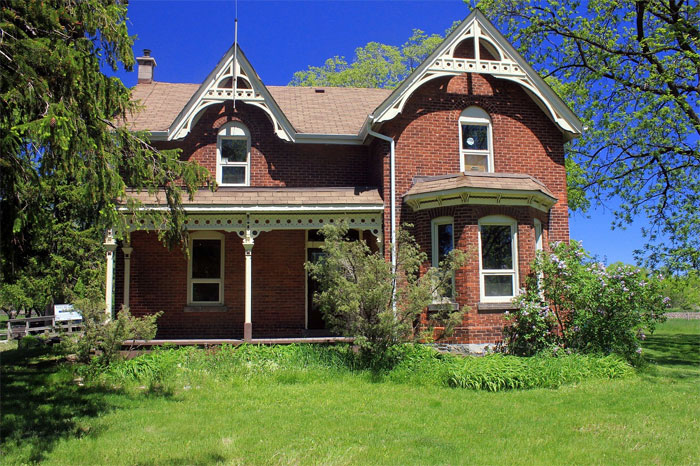Beaucoup de Baby boomers ont en projet de devenir propriétaire d’une nouvelle maison. Reste qu’ils doivent penser à également économiser pour vivre confortablement pendant leurs retraites.
;
Many members of the Baby Boomer generation(1) have new homes and money on their minds, as dreams of buying retirement homes mix with concerns about how to get enough dollars in their pockets to carry them through the golden years, according to the 2005 Del Webb Baby Boomer survey.
;
Among younger Boomers, ages 41-49, 59% of respondents plan to buy a new retirement home, while 50% of those older Boomers ages 50-59 intend to do likewise.
;
Given that there are an estimated 77.5 million Baby Boomers(2), and they are one of the wealthiest generations in American history, retirement home purchasing among active adult buyers over the next few decades is expected to be considerable.
;
At the same time, Baby Boomers indicated uncertainty over how much money they’ll need to save for retirement and where it’s going to come from. Just over half of all Baby Boomers surveyed (52% younger Boomers, 54% older Boomers) say they feel they have a solid understanding of the issues facing Social Security today, with 62% of Boomers ages 41-54 believing the system is « in crisis. » A full 75% of the same 41-54 age group say they aren’t planning to rely solely on Social Security for retirement, and 81% of respondents ages 55-69, many of whom currently draw benefits, say they, too, don’t plan to count fully on Social Security.
;
« A lot of Boomers want new homes and a new lifestyle for retirement, but they may have to change a few things first, » says Dave Schreiner, vice president of active adult business development for Pulte Homes (Del Webb is a brand of Pulte Homes). « They recognize they may have to save more money or start thinking harder about a semi-work, semi-retirement arrangement, which isn’t a huge shift from what we’re experiencing today. A large number of Del Webb residents are starting new businesses, getting retrained and staying connected to the workforce. They don’t leave it entirely. That’s one advantage of positioning our newer communities close to large metropolitan centers – that’s where the jobs are. »
;
Pulte Homes is the nation’s largest developer of active adult communities. Reflecting a strong commitment to consumer research, including the annual Del Webb Baby Boomer survey, Pulte’s Del Webb communities throughout the United States have evolved to meet the changing preferences of age 55 and older homebuyers. This year’s study, conducted by Harris Interactive®, was designed to understand Boomers’ opinions about critical issues they face, including finances and the impact of possible changes to Social Security, real estate, retirement lifestyle and work habits.
;
Data for the survey was analyzed by various age subgroups to see if there were any key differences of opinion among Boomers ages 41-49; Boomers ages 50-59; and their predecessors ages 60-69. Data also was broken down according to those people expected to be most affected by any changes to Social Security (ages 41-54) and relatively unaffected (ages 55-69).
;
Highlights of the 2005 Del Webb Baby Boomer Survey
;
Real Estate
;
More than half of Boomers plan on buying a new home for retirement. About half of Boomers expect to move to another state at retirement, with many seeking a better community lifestyle.
59% of younger Boomers (ages 41-49) and 50% of older Boomers (ages 50-59) indicate they plan to buy a new home for their retirement.
;
Of Boomers willing to move at retirement, 66% of older Boomers indicate they would move for a better community lifestyle, and 54% would seek a warmer climate.
;
Nearly half (47%) of all respondents (ages 41-69) who will move say staying within three hours of family would be an important consideration about where to relocate for retirement.
;
;
Among those willing to move to a different state, the most-preferred states to move to for retirement, by age group, are: Ages 41-49, North Carolina (14%); ages 50-59 and 60-69, Florida (18% and 17%, respectively).
;
« There’s a secret weapon in our business and it’s called grandkids, » Schreiner said. « For those people who have them, many want us to deliver the Del Webb lifestyle to where they currently live. Staying close to family and friends, and maintaining links to their community are important things to them. And there are plenty of these ‘retire in place’ people in markets like Denver, Cleveland and Detroit, which is where we plan to open new Del Webb communities later this year. »
;
Social Security
;
Boomers most affected by potential changes in Social Security (ages 41-54) are more likely to believe they will need another source of income to finance their retirement, and are more likely to invest in private accounts.
;
62% of Boomers ages 41-54 believe the program is in crisis, and 34% of this group expressed an interest in investing a portion of Social Security in a private account.
;
Although 61% of non-retired Boomers ages 41-54 say they don’t know what their monthly benefit will be at retirement, 75% of all respondents ages 41-54 say they do not plan to rely solely on Social Security benefits.
;
Uncertainty about Social Security has caused 25% of non-retired Boomers ages 41-54 to admit they won’t retire as soon as expected, but 62% of nonretired respondents ages 55 and older say they’ll retire on schedule.
;
79% of older respondents, ages 60-69, believe they are receiving or will receive full benefits.
« There is definite uncertainty about the future among Boomers today, » Schreiner said. « But, we find that people moving into Del Webb communities see them as havens of certainty. First, they’re very trustworthy developments. We’ve been doing this for forty-five years. We start and finish communities that last. It’s a very predictable concept.
;
« Second, we’re very good at managing these communities, so we have appropriate budgets, » Schreiner added. « Our customers know when they move in what it’s going to cost them now and they have a solid idea of what it’s likely to cost them out into the future. Those are very comforting notions in an uncertain world. »
;
Finances
;
Also on the minds of Boomers, according to this year’s survey, is the rising cost of health insurance and prescription medicines that they anticipate needing.
;
Regardless of age, all respondents said health care related costs topped their respective lists of financial concerns during retirement, including health insurance (74%), prescription medicine (71%) and long-term care insurance (58%).
;
In projecting their longevity (if healthy), 40% of all respondents said they hope to live to 80 to 89 years of age, 20% said 90-99, and 22% said 100 or older. But when asked to estimate how long their savings would need to last after retirement, 42% of all respondents said they weren’t sure.
;
Of all respondents, 17% estimated they would require savings of between $500,000 and $1 million to live comfortably throughout retirement, 15% said between $200,000 to $500,000, and 12% estimated needing between $1 million and $2 million.
;
A pension from a former employer was the third most-important source of retirement income for respondents ages 50-59 (48%) and 60-69 (47%).
;
« When Del Webb built the first Sun City in Arizona in 1960, most people of that generation expected to live ten more years after retiring, » Schreiner said. « Today, the good news is once you pass from your child-rearing, career-oriented stage of life into this new stage you might live another forty years. The possibilities to grow, to experience new things, to get further education, are all in front of you and most people have great zest for that in this stage of their life.
;
« Now, the flip side, physically, is that your body has to make it through another forty years, » Schreiner said. « Concerns about the future of Medicare and rising health care costs definitely play into that. As a result, more residents in our communities today are putting a lot of effort into improving their health at our world-class fitness and wellness centers. More push-ups equals fewer pills, they figure. »
;
Retirement Lifestyle
;
Anticipation of retirement increases with age as Boomers look forward to active pursuits such as traveling, exercising, volunteering or even continuing working, either full- or part-time.
Enthusiasm about pending retirement increases with age among respondents in their 40s and 50s, with 45% and 56% indicating « excitement, » respectively.
;
Travel (62%) tops the list of desired retirement activities across all ages. Other popular interests are spending time with friends/loved ones (42%), exercising more (42%), volunteering (37%), taking up a hobby (33%), acquiring new skills (29%) and taking classes (25%).
;
If they could « go back » to another decade of their life, most would choose their 30s (31%) and 20s (28%).
;
Work Habits
;
While some Boomers plan to continue working because they enjoy it, 64% of all respondents still working outside the home said they will fully retire from their current line of work at some point. But, among those planning to continue working, the reasons differ by age.
;
Of those who will continue to work, 49% of younger Boomers, ages 41-49, and 37% of older Boomers, ages 50-59, plan to continue because they need the money.
;
Of those who will continue to work, 33% of pre-Boomers, ages 60-69, say they will continue because they enjoy it, and 22% of this group will continue because « it keeps me active. »
;
45% of all respondents working outside the home say they typically work 31-40 hours per week.
« Retirement isn’t seen as the end game anymore, » Schreiner said. « It’s a life transition. These people want to stay active and engaged, mentally, physically and socially, for as long as possible. They want a great quality of life over the next forty years and working, in some capacity, is a part of that. In some of our communities, as many as 40 to 50% of homeowners hold down either a full-time or part-time job.
;
« It’s quite possible that someday you’ll see the first Del Webb community located next to an office park, instead of a shopping mall or medical center, » he added. « And local colleges and universities will tailor extension courses that ignite a newfound entrepreneurial spirit in more of our residents. »
;
Pulte Homes currently addresses the needs of Boomers who continue working once they move into a Del Webb community. At several communities in Southern California, Pulte Homes and Verizon install fiber optic cable to homes in order to deliver true business-class Internet service. Sun City Grand in Surprise, Ariz., offers homebuyers the chance to upgrade wiring systems that provide high-speed Internet connections and additional fax lines to a home office.
;
More residents at Del Webb communities across the country are turning a spare bedroom into a home office, and in some communities in the western United States homeowners are paying extra to have detached « casitas » built to serve as a home office.
;
Also, many fitness centers at Del Webb communities now open for business as early as 5 a.m. and stay open as late as 9 p.m. in order to accommodate working residents who wish to either start or end their workday with a workout.
;
The term « Baby Boomer Generation » defines those Americans born between 1946 and 1964, or those who are now 41-59 years old. The huge population « boom » came after American soldiers returned from World War II and prior to the widespread use of birth control in the mid-1960s. As America’s 76 million Boomers move from parents, to empty nesters, to retirees, to old age, they continue to have a profound impact on social, political and economic issues.
;
Survey Details
The 2005 Del Webb Baby Boomer survey report can be found at http://onlinepressroom.net/pulte/babyboomer. For additional information, please visit www.pulte.com or www.delwebb.com.
Harris Interactive® conducted the online survey on behalf of Pulte Homes between April 14-20, 2005, among 1,802 adults aged 41-69 who live in 10 different regions of the U.S.: the Northeast, Southeast, Florida, Great Lakes, Texas, Rocky Mountains, Arizona, Nevada, Northern California, and Southern California. The data for this study were weighted to represent the total population of adults aged 41-69 within these regions for age, race/ethnicity, sex, education, income, region and propensity to be online. In theory, with probability samples of this size, one could say with 95 percent certainty that the overall results have a sampling error of +/- 3 percentage points. Sampling error for the various sub-sample results is higher and varies. This online sample was not a probability sample.
;
;
;




